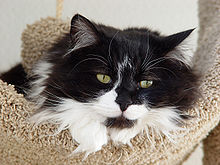- Domestic longhaired cat
-
A domestic longhaired cat is a cat fancy term used to describe a cat with medium or long fur that is not a pedigreed member of a recognized breed. Domestic longhairs come in all the standard cat colours including tabby, tortie, bi-colored, smoke etc. A non-pedigree shorthair is termed a domestic shorthaired cat.
Some longhaired cats are not able to maintain their own coat - they must be groomed for at least half an hour per day, and preferably bathed every week or two[citation needed]. The cat may not enjoy the bathing process, but if it is bathed and groomed regularly from kittenhood it will accept it as a standard part of its routine.
Very long-haired cats do not make good outside animals, as their coats are extremely prone to matting. In extreme cases, the mats come to resemble wings, leading to stories of winged cats.
The matted fur will usually accumulate in the under arm areas and upper leg region of a long haired cat. In extreme circumstances, the matted fur can inhibit the cat's movements and cause irritation, and can cause the cat to become caught on outside shrubs and trees. When this occurs, the cat's forceful attempts to break away can pull large amounts of clumped fur away, leaving bald areas and possible injuries. If such matting of fur occurs, a simple de-matting comb for cats or dogs will be sufficient to detangle it. At first, the cat may be irritated by the comb, but gentle brushes each day to ease the fur off will gradually work out the matted areas, and continued brushing thereafter can help prevent large clumps of fur from appearing again.
Many owners of long haired cats -- especially new owners -- may feel tempted to cut tangled or matted fur away with scissors in lieu of combing it out. This should not be done by any owner not trained to do so, as it can be difficult to distinguish between hard-matted fur and the skin of a cat. In addition, in extreme circumstances, heavy-matted fur will harbour bacteria-infested soil or vegetation, which can cause infection to any cuts accidentally inflicted on the cat by an untrained owner attempting to cut out matted fur. If a de-matting comb does not work well enough, the cat should be taken to a groomer, or, in rare cases, a veterinarian, who may remove heavy matted fur with electric clippers fitted with a guard to prevent injury to the cat. However, the owner of the cat should never try to remove the loose fur by themselves; they could injure the cat that they were attempting to help.
See also
Categories:- Cat types
- Cat breeds
- Cat breeds originating in the United States
Wikimedia Foundation. 2010.


